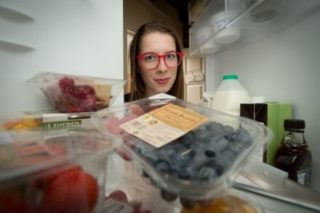In the final installment of our Shell LiveWIRE feature series, Today Translations speaks to Solveiga Solveiga Pakštaitė, a graduate of Brunel University who has designed, amongst other things, the Bump Mark technology, which aims to tackle the terrible wastages of food across Britain and ultimately the world that needlessly occur every single day. Our CEO Jurga Žilinskienė was thoroughly impressed by this budding young businesswoman, also of Lithuanian heritage, and the clarity of her vision to revolutionize our attitudes to food waste.
Having won the Shell LiveWIRE Smarter Future award in March 2015, she was met with further distinction at the Shell LiveWIRE annual ceremony, winning the Shell Staff Inspiration Award. She had previously won several other sustainable design awards, and has been featured multiple times in media outlets such as the Guardian.
Earlier this month, Solveiga was kind enough to speak to Today Translations about her Bump Mark project, and the places it might take her…
1. What is Bump Mark, and what problems does it address?
60% of the food the UK throws away could have been eaten – this is unacceptable. Food waste is a monumental global issue that the Bump Mark food expiry label can significantly reduce by providing accurate, real-time information about the freshness of the food inside the package. It uses patent pending bioreactive technology, meaning it goes bad exactly when the food inside the package does too, so we don’t throw away food food which will protext the environment and our money. Because the label changes texture from smooth to bumpy, it is ideal for visually impaired consumers as well.
The key technology is the bioreactive gelatine component of the label. Gelatine is a protein, and so it decays at the same rate as protein-based foods. The label simply copies what the food in the package is doing, so the expiry information is going to be far more accurate than a printed date. Of course, various foods expire at different rates, but the Bump Mark label can very accurately be ‘mapped and matched’ to each specific food. This can be done simply by altering the concentration of the gel, so the higher the concentration, the longer the label will hold, due to more bonds in the gel structure.
2. What inspired you to develop your product?
I actually initially set out with the aim of improving access to food expiry information for visually imapired people, but with global food waste figures at their historical high, I quickly became determined to create a solution that would start to change people’s attitude and behaviour towards throwing away perfectly good food. It is irrational that in an tracking and quantifying-obsessed world, that we’re still in the dark about the condition of one of our most precious resources – food. The inspiration for the actual Bump Mark solution struck when I was looking at an old banana… its skin was trying to tell me something and I wondered why plastic packaging doesn’t behave in the same way.
3. What traits do you think a successful entrepreneur needs to have?
I strongly believe that the most dangerous sentence is ‘but that’s the standard’ as I feel it inhibits critical thinking and innovation. To me, a successful entrepreneur is not afraid to explore their curiosities outside of the societal norm and is bold in their execution.
4. Is there enough of a focus on sustainability amongst British innovators?
I really feel that London is the world’s capital of sustainable innovation and there are so many amazing initiatives for supporting people who have clever ideas on how to tread lightly on this planet. I think it’s a shame that in contrast, the UK’s sustainability policies are a step behind the rest of Europe. I hope this turns around in the next few years.
5. What goals do you have for your firm following Shell LiveWIRE?
We will be using the £5000 to fund our student summer internship programme. We are looking for science and engineering students that want to get some hands-on work experience and be a part of getting Bump Mark to its first retail trial later this year.
6. Where do you see yourself and your brand in five years’ time?
I believe that if the only knowledge that we impart onto consumers is whether or not a certain food can be eaten at a specific time, then we have failed. I feel we have a responsibility to change the industry for the better, by introducing tools that provide more intelligent monitoring of our resources. As well as this, creating channels through which to offer better food education is going to have a far greater effect on future efficient use of resources than the information the Bump Mark can offer alone. We want to teach the younger generation about the value of food through growing their own and teach their parents tricks for checking the freshness of their foods on products that are yet to benefit from the Bump Mark. Everybody should have access to this information and play a part in a sustainable mission.
7. The idea clearly has global potential. Do you envision launching it in foreign countries? If so, which ones would you prioritise?
I think that after launching in the UK market, we will find success in France, given their radical food waste reduction policies and the sustainability-conscious Scandinavian countries.
8. What challenges do you think would come with launching in foreign markets?
Because our business model is a technology licensing one, our intellectual property is our most important asset. We’re currently going through the process of planning which countries to expand our patent into and getting fast and getting high quality translations of our applications will be critical to the level of protection we’re awarded worldwide.
To keep up top date with Solveiga’s exciting journey, or to find out more about her other projects, find her at the Twitter handle @Design_By_Sol, or the website http://www.designbysol.co.uk/

